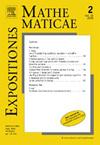端和端上同调
IF 0.9
4区 数学
Q2 MATHEMATICS
引用次数: 0
摘要
端和端上同调是研究非紧空间的重要不变量。我们提出了端点的拓扑理论的一个独立的阐述,并证明了新的扩展,包括一个固有映射的耗尽的存在。我们将约端上同调定义为射线基空间的相对端上同调。我们利用这些结果证明了King的一个定理的一个版本,该定理计算了两个流形的端和的化简端上同调。我们在拓扑群的端点数上完整地证明了Freudenthal的基本定理,并利用零维端点上同的结果,在不使用超限归纳法的情况下证明了一个关于连续函数的某些模的自由度的定理Nöbeling。本文章由计算机程序翻译,如有差异,请以英文原文为准。
Ends and end cohomology
Ends and end cohomology are powerful invariants for the study of noncompact spaces. We present a self-contained exposition of the topological theory of ends and prove novel extensions including the existence of an exhaustion of a proper map. We define reduced end cohomology as the relative end cohomology of a ray-based space. We use those results to prove a version of a theorem of King that computes the reduced end cohomology of an end sum of two manifolds. We include a complete proof of Freudenthal’s fundamental theorem on the number of ends of a topological group, and we use our results on dimension-zero end cohomology to prove—without using transfinite induction—a theorem of Nöbeling on freeness of certain modules of continuous functions.
求助全文
通过发布文献求助,成功后即可免费获取论文全文。
去求助
来源期刊
CiteScore
1.30
自引率
0.00%
发文量
41
审稿时长
40 days
期刊介绍:
Our aim is to publish papers of interest to a wide mathematical audience. Our main interest is in expository articles that make high-level research results more widely accessible. In general, material submitted should be at least at the graduate level.Main articles must be written in such a way that a graduate-level research student interested in the topic of the paper can read them profitably. When the topic is quite specialized, or the main focus is a narrow research result, the paper is probably not appropriate for this journal. Most original research articles are not suitable for this journal, unless they have particularly broad appeal.Mathematical notes can be more focused than main articles. These should not simply be short research articles, but should address a mathematical question with reasonably broad appeal. Elementary solutions of elementary problems are typically not appropriate. Neither are overly technical papers, which should best be submitted to a specialized research journal.Clarity of exposition, accuracy of details and the relevance and interest of the subject matter will be the decisive factors in our acceptance of an article for publication. Submitted papers are subject to a quick overview before entering into a more detailed review process. All published papers have been refereed.

 求助内容:
求助内容: 应助结果提醒方式:
应助结果提醒方式:


